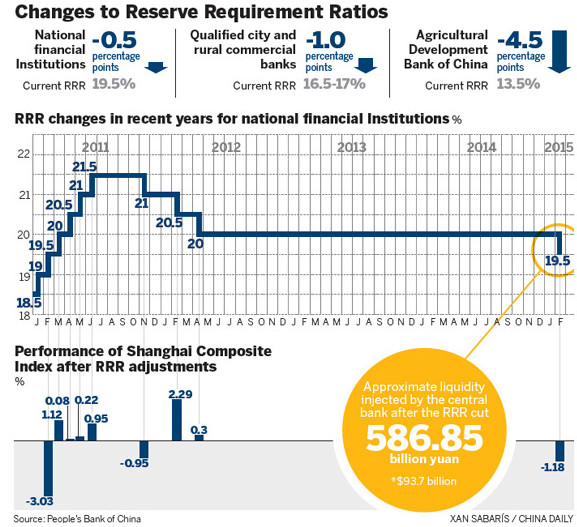

The People's Bank of China became the 16th global central bank to ease monetary policies this year, after it reduced reserve requirements or the amount of cash banks must hold back from lending, starting from Thursday.
The PBOC said it will lower the RRR for all financial institutions by 50 basis points, making it the first broad cut since May 2012. Meanwhile, an additional targeted RRR cut will take effect for city and rural commercial banks with sufficient exposure to small and medium-sized enterprises. The RRR for the Agricultural Development Bank of China will be lowered by 450 basis points.
Though the RRR cut is more of a follow-up measure to the steps announced by other central banks, it also means that the Chinese currency is entering an era of depreciation, said Lu Zhengwei, chief economist at Industrial Bank Co Ltd.
Due to the global deflation pressure arising from falling crude oil prices, most of the global economies have come out with various monetary policies, but all with the same objective-to boost economic growth amid the slow recovery after the financial crisis.
Following the US Federal Reserve's announcement that it ended bond purchases or the quantitative easing policy in October, the market expects that it would hike the policy rate in the second half of this year.
On the contrary, the European Central Bank released its quantitative easing plan in January, after it cut the policy rate to below zero and introduced measures to increase liquidity.
Meanwhile, the Bank of Japan has decided to expand the size of its monetary stimulus plan.
A positive economic growth expectation in the US and the possibility of higher interest rates have lifted the dollar's value against the euro and yen.
As the dollar becomes stronger and domestic property prices slump, China will see huge outflows of capital, much higher than the level seen in the last quarter of 1998, amid the Asian financial crisis. Capital outflows excluding foreign direct investment may have reached $160 billion in the fourth quarter of 2014, accounting for more than half of the full-year amount.
The RRR reduction is expected to inject as much as 600 billion yuan into the banking system, in order to offset the large capital outflows.
Xu Hongcai, a senior economist at the China Center for International Economic Exchanges, a government think tank, said: "It is not right to say that China has joined the global 'currency war'. But policymakers should pay more attention to the recent cross-border capital flows and exchange rate fluctuations before they take further steps to stabilize growth.
"We expect the major economies to improve macro policy communication and cooperation to prevent large debt crises and financial fluctuations in the global markets."
According to estimates from the Economist Intelligence Unit, the dollar may continue to appreciate in the next 18 months, and the average dollar-to-euro exchange rate is likely to be 1:1.08. If the US maintains a relatively tight monetary policy, more capital flows from the emerging markets to the US may be seen in the coming months, it said.
Wang Tao, chief economist in China at UBS AG, expects the PBOC to make further cuts to the RRR, especially if the capital outflows continue and the domestic liquidity is still constrained.
Song Yu, an economist with Goldman Sachs Group Inc, said that the government may allow the renminbi to depreciate against the dollar to ease pressure on export growth.
RRR cut fails to spur rise in mainland exchanges
2015-02-06China stocks down despite RRR cut
2015-02-05China‘s RRR cut not start of strong stimulus: official
2015-02-06Cut in RRR extends to bigger lenders
2014-06-17Copyright ©1999-2018
Chinanews.com. All rights reserved.
Reproduction in whole or in part without permission is prohibited.